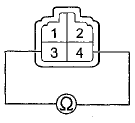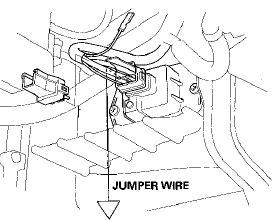 Honda Accord: Power Transistor Test
Honda Accord: Power Transistor Test
1. Remove the passenger's dashboard undercover (see page 20-170).
2. Disconnect the 4P connector from the power transistor.
3. Measure the resistance between terminals No. 3 and No. 4 of the power transistor. It should be about 1.5 kO.
• If the resistance is within the specifications, go to step 4.
• If the resistance is not within the specifications, replace the power transistor.
NOTE: Also check the blower motor. Power transistor failure can be caused by a defective blower motor.
POWER TRANSISTOR

4. Carefully release the lock tab on terminal No. 1 (PUR) (A) in the 4P connector, then remove the terminal and insulate it from body ground.

(To 12 V Power source on vehicle)
5. Reconnect the 4P connector to the power transistor.
6. Make sure the PUR wire is completely isolated, then supply 12 V to cavity No. 1 with a jumper wire.
7 Turn the ignition switch to ON (II), and check that the blower motor runs.
• If the blower motor does not run, replace the power transistor.
NOTE: A faulty blower motor can cause the power transistor to fail. If the power transistor is replaced, also check the blower motor for binding, and replace it if necessary.
• If the blower motor runs, the power transistor is OK.
 Evaporator Temperature Sensor Test
Evaporator Temperature Sensor Test
NOTE: Before testing the sensor, check for HVAC DTCs
(see page 2 1 - 9).
1. Remove the evaporator temperature sensor (see
page 21-67).
2. Dip the sensor in ice water, and measure the
resistan ...
 Air Mix Control Motor Test
Air Mix Control Motor Test
NOTE: Before testing the motor, check for HVAC DTCs
(see page 21-9).
1. Disconnect the 7P connector from the air mix control
motor.
Incorrectly applying power and ground to the air mix
contro ...
See also:
iPod Error Messages (Models without navigation system)
If you see an error message on the
audio display while playing an iPod,
find the solution in the chart to the
right. If you cannot clear the error
message, take your vehicle to your
dealer.
...
Seat Belt Maintenance
For safety, you should check the
condition of your seat belts regularly.
Pull each belt out fully, and look for
frays, cuts, burns, and wear. Check
that the latches work smoothly and
the belt ...
Hood Latch Replacement
NOTE:
- Put on gloves to protect your hands.
- Take care not to scratch the body or the related parts.
1. Remove the front grille cover:
- 2-door (see page 20-274)
- 4-door (see page 20-274)
...
